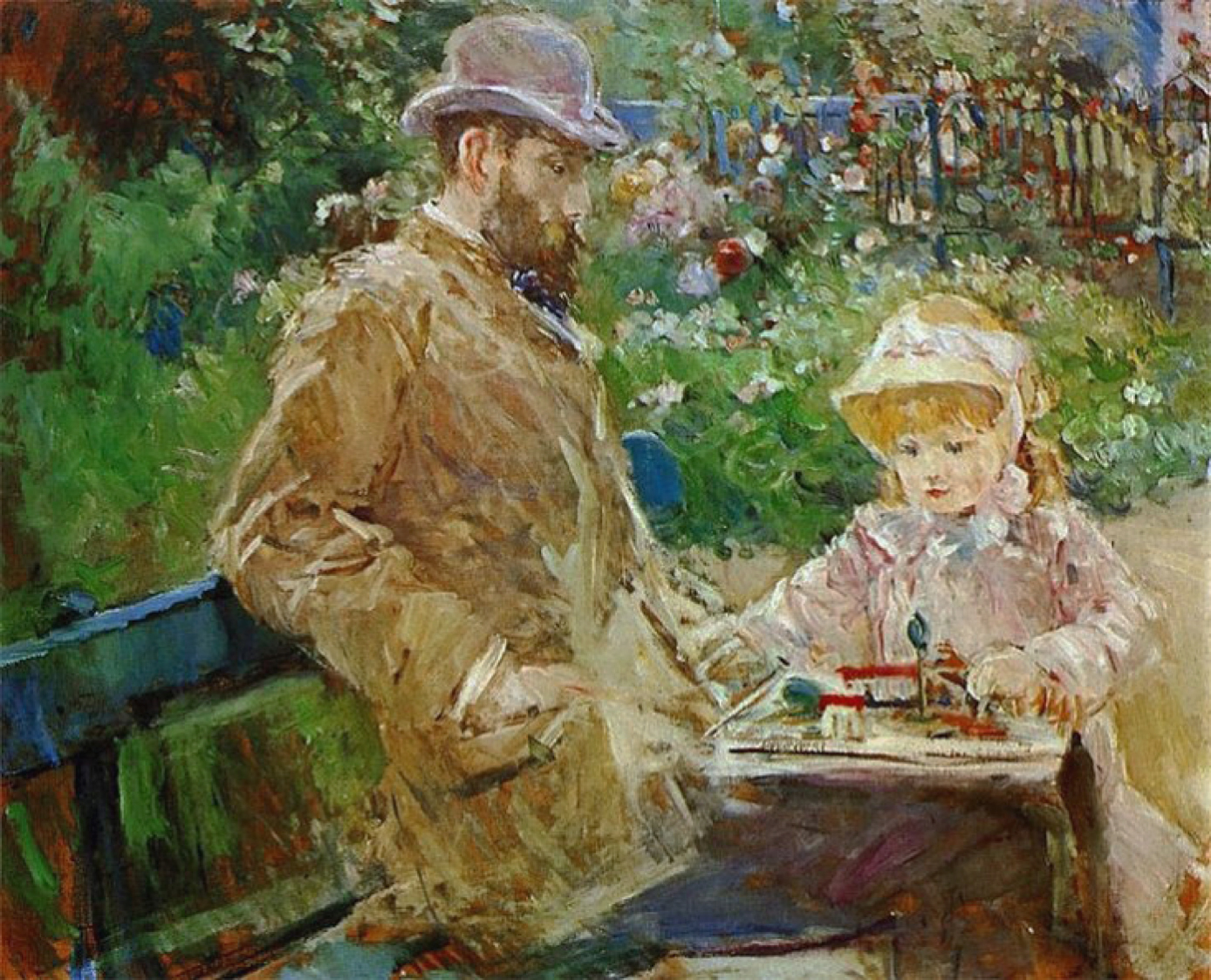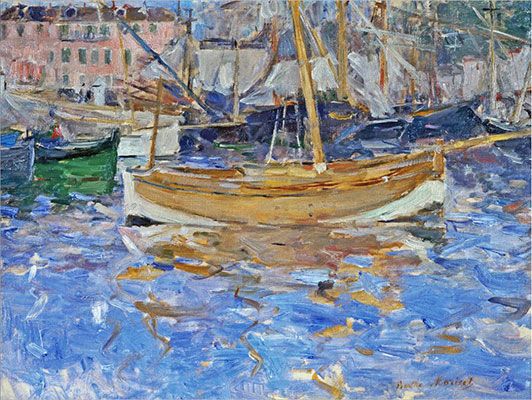- Berthe Morisot One of 'Les Trois Grandes Dames,' Berthe Morisot was a highly regarded Impressionist artist, and drew in audiences with her intimate paintings of domestic scenes and landscapes. Track Your Order.
- Paintings that portray a working woman artist from the time is Edma's Berthe Morisot Painting. In it, Berthe Morisot confronts a canvas with dirty brushes and an intense glare. She is a painter, not simply a woman painting. It is a picture quite unlike Maner's Portrait of Eva Gonzales, painted only a few years later, which portrays Eva Gonzales.
- The Estate of Berthe Morisot and their presence hold all necessary copyrights and licences for all of his paintings and other works. All prints, paintings and photos included in www.Berthe-Morisot.com are provided as an affiliate to Art.com who hold necessary permissions.
- Berthe Morisot, “Woman at Her Toilette” (1875–1880), oil on canvas (the Art Institute of Chicago, Inv. 1924.127., photo courtesy the Art Institute of Chicago / Art Resource, NY).
Background

Berthe Morisot is one of the founding yet least famous of the Impressionist painters. Unlike her contemporaries Renoir and Monet her name has never achieved the same household recognition, perhaps because Morisot was a woman. Nevertheless in recent times critics have hailed Berthe Morisot's work as exceptional and she referred to as one of the finest female artists of the 19th century.


In his relatively short but eventful career as an artist, Edouard Manet sought to reconcile his respect for the Old Masters - in particular, the school of Spanish painting - with Baudelaire's call for an art reflecting modern life. Amazingly, by combining the best of academic art with some of the characteristics of Impressionism, he managed to introduce a highly innovative form, of modern art that influenced a wide circle of his contemporaries. This felicitous fusion of old and new is exemplified by his Portrait of Berthe Morisot, one of the finest Impressionist portraits of the French school, which ranks alongside Valentin Serov's sublime Portrait of Isaac Levitan (1893, Tretyakov Gallery, Moscow). Other masterpieces by Manet include: Dejeuner sur L'Herbe (1863), Olympia (1863), Portrait of Emile Zola (1868), Road-Menders in the Rue de Berne (1878) and A Bar at the Folies-Bergere (1882).
NOTE: For the full story behind Impressionism and the group of young Parisian painters who created it, see our 10-part series, beginning: Impressionism: Origins, Influences.
Berthe Morisot Works
This painting (sometimes known as Berthe Morisot in a black hat or Young woman in a black hat) shows Berthe Morisot dressed in black mourning dress, holding a barely perceptible bouquet of violets. (Note: Manet also included violets in his Woman with a Parrot, 1866). Morisot - whom he had met through Henri Fantin-Latour (1836-1904) - was one of his favourite models, whom he had known since 1868 and with whom he shared a close friendship. Two years after sitting for this portrait she would marry one of his brothers. This picture was one of four portraits that Manet painted of Morisot, whom he also included in his genre painting The Balcony (1868). See also his portrayal of Morisot in Repose (1869-70, Rhode Island Museum of Art).

Manet was especially influenced by Spanish Old Masters such as Velazquez (1599-1660) and Goya (1746-1828) - whose works he copied in the Louvre and also saw in person during a study trip to Spain in 1865 - both of whom were virtuoso handlers of the black colours and tones. Perhaps not surprisingly therefore, he depicts Morisot in black hat, black dress and with black eyes (they were in fact green), to highlight her 'Spanish' beauty - an attribute mentioned several times since her first appearance in Manet's work in 1869.
Berthe Morisot was a renowned French Impressionist artist, widely celebrated for her landscapes, portraits and remarkably impressive still lives and domestic scenes.
Berthe Morisot was born on January 14, 1841, in Bourges, France. Her grandfather, Jean-Honore Fragonard, was a renowned and notable Rococo painter, while her father was an influential and high-ranking government official. Artistic education and training was encouraged in her household, and from a very young age, Berthe and her sister Edma began her training in arts and painting. The conventional society of France did not encourage the participation of women in visual arts and hence, the young girls were not allowed to study at the official art institutions. Despite that, their talent and skill was appreciated and widely discussed in the art circles and influential societies of France.
In the late 1850s, Berthe and Edma travelled to Paris and began their training under the tutelage of Joseph Guichard, they began studying and copying the works of the Old Masters at the Louvre Museum. Later, they studied under notable and influential landscape artist Jean-Baptiste Camille Corot, who taught them the details and expertise of painting outdoor scenes. Berthe Morisot began working with Corot, and in 1864, she showcased her first exhibition at the prestigious and influential state organized art show, the Salon. The show was a fabulous success and Berthe earned a regular spot at the show for the next ten years.

Berthe Morisot Exhibition
In 1868, Berthe was introduced to Édouard Manet, and the two formed a mutual connection and a lifelong friendship. Edouard had a profound influence on Berthe’s work, and she gave up the styles and practices that she had learnt with Corot and adopted Manet’s experimental, unconventional and modernistic style that encouraged her freedom of expression. During the same period, she also became friends with several influential Impressionists including Edgar Degas and Frédéric Bazille, whose work had an impact on her artistic approach.
In 1874, Berthe refused to showcase her work at the Salon, and instead, she collaborated with several notable Impressionists, including Edgar Degas, Camille Pissarro, Pierre-Auguste Renoir, Claude Monet and Alfred Sisley among others, and showcased her work at the first independent show of Impressionists paintings. Among the paintings that Berthe showcased at the show included, The Harbour at Cherbourg, Reading, Hide and Seek and The Cradle.
The same year, she married Manet’s brother, Eugene Manet, and this union provided her social standing and financial security, and allowed her to break free of all social and financial constraints and experiment the depths of her artistic expressions and talent. She began dedicating time to her craft and became a regular participant at the Impressionists exhibitions each year. However, she was unable to take part in the exhibition in 1877, as she was expected her first child, a daughter.
Berthe Morisot continued to get acclaim and fame for her artistic talents and expressions, however her paintings did not meet much commercial success during her life. However, her work had several influential patrons and her paintings would regularly outsell the works of several notable Impressionists such as Renoir, Sisley and Monet.
Berthe Morisot Paintings And Descriptions
Her husband passed away in 1892, Berthe kept herself steady and strong during her difficult and grievous time, and devoted her time to her artistic passions and painted her sorrow on to the canvas. The same year, she organised her first solo exhibition that proved to be an immense success. In 1894, the French government purchased her famous oil painting, Young Woman in a Ball Gown.
Berthe Morisot Impressionist Paintings
In 1895, at the age of 54, Berthe Morisot became infected with a severe and terminal case of pneumonia and after a painful suffrage, she passed away on March 2, 1895. Her work is celebrated for its fineness and its startling attention to detail, she was particularly famous for her landscapes, still lives, portraits and domestic scenes. Some of her widely acclaimed and celebrated works include, Woman at Her Toilette, The Cherry Tree and Girl with a Greyhound.